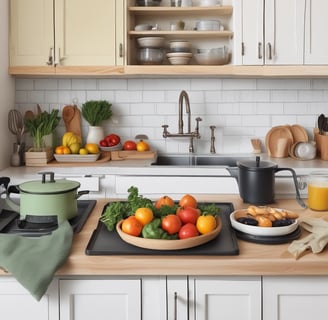10 Simple Swaps to Make Your Kitchen More Eco-Friendly
10 Simple Swaps to Make Your Kitchen More Eco-Friendly shares easy, impactful changes—like using reusable containers and composting scraps—that help reduce waste, cut down on plastic, and create a more sustainable kitchen.
5/5/20253 min read


Making your kitchen more eco-friendly doesn’t require a complete overhaul. Small changes in your daily routine and the products you use can have a big impact on reducing waste and conserving resources. By swapping out a few common items and practices, you can create a kitchen that is both environmentally friendly and functional. Here are 10 simple swaps to help make your kitchen more eco-friendly:
1. Swap Single-Use Plastic Bags for Reusable Produce Bags
Plastic bags are a major environmental concern. Instead of using plastic produce bags at the store, swap them for reusable mesh or cotton bags. These durable alternatives can be washed and reused many times, reducing waste.
2. Swap Plastic Wrap for Beeswax Wraps
Plastic wrap is often used to cover leftovers or store food, but it’s not the best option for the environment. Beeswax wraps are a great alternative. They’re reusable, biodegradable, and can easily be cleaned with mild soap and water. Plus, they come in a variety of fun patterns!
3. Swap Paper Towels for Reusable Cloth Towels
Paper towels contribute to deforestation and waste. Swap them out for reusable cloth towels or rags. These can be used multiple times, washed, and replaced over time—significantly reducing your paper waste.
4. Swap Disposable Coffee Pods for a Reusable Coffee Filter
Single-use coffee pods have become a popular convenience, but they often end up in landfills. Consider switching to a reusable coffee filter or French press. These alternatives eliminate the need for single-use plastic pods and can be used for years.
5. Swap Plastic Containers for Glass or Stainless Steel Storage
Plastic containers are convenient but not the most eco-friendly option. Instead, opt for glass or stainless steel storage containers. These materials are more durable, and they won’t leach chemicals into your food. Plus, they last longer and are recyclable.
6. Swap Nonstick Cookware for Cast Iron or Stainless Steel
Many nonstick cookware options contain harmful chemicals like PFOA and PFAS, which can be harmful to both your health and the environment. Swap these for natural materials like cast iron or stainless steel, which are non-toxic and built to last for generations.
7. Swap Plastic Sponges for Natural Dish Scrubbers
Most dish sponges are made from synthetic materials that don’t break down easily and can contribute to microplastic pollution. Instead, choose natural sponges or scrubbers made from materials like bamboo, coconut fibers, or cellulose. These alternatives are biodegradable and just as effective at cleaning.
8. Swap Canned Foods for Fresh or Frozen Options
Canned foods often come in metal containers lined with harmful BPA, and the process of canning itself involves a significant amount of energy. Whenever possible, swap canned foods for fresh or frozen alternatives. Not only will this reduce your exposure to chemicals, but it also often results in fewer preservatives.
9. Swap Plastic Straws for Reusable Options
Plastic straws are a major contributor to ocean pollution. Instead of using disposable plastic straws, swap them for reusable alternatives like stainless steel, bamboo, or silicone. These materials are durable, washable, and can be reused countless times.
10. Swap Chemical Cleaners for Natural Cleaning Solutions
Conventional cleaning products often contain harsh chemicals that are not only bad for your health but also harmful to the environment. Make the switch to natural cleaning solutions using ingredients like vinegar, baking soda, and lemon. These eco-friendly cleaners are just as effective at cleaning but without the toxic chemicals.
Conclusion
Making eco-friendly swaps in the kitchen is a simple but impactful way to reduce your carbon footprint, save money, and contribute to a healthier planet. Start by replacing one or two items, and gradually incorporate more sustainable options into your daily routine. With these small changes, you’ll be able to enjoy a cleaner, greener kitchen while also making a positive impact on the environment.
Sustainability doesn’t have to be overwhelming. Every small action counts.
